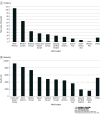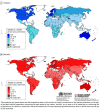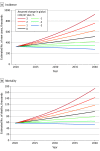Global Burden of Cutaneous Melanoma in 2020 and Projections to 2040
- PMID: 35353115
- PMCID: PMC8968696
- DOI: 10.1001/jamadermatol.2022.0160
Global Burden of Cutaneous Melanoma in 2020 and Projections to 2040
Abstract
Importance: Despite many cases being preventable, cutaneous melanoma remains the most serious skin cancer worldwide. Understanding the scale and profile of the disease is vital to concentrate and reinforce global prevention efforts.
Objective: To examine global patterns of cutaneous melanoma in 2020 and to provide projected estimates of cases and deaths by 2040.
Design, setting, and participants: This population-based study used the GLOBOCAN 2020 database for global epidemiological assessment of new cases and deaths due to invasive melanoma.
Main outcomes and measures: Age-standardized incidence and mortality rates were calculated per 100 000 person-years by country, world region, and 4-tier level of human development. Estimated numbers of cases and deaths were calculated for the year 2040.
Results: A worldwide total of 325 000 new melanoma cases (174 000 males, 151 000 females) and 57 000 deaths (32 000 males, 25 000 females) was estimated for 2020. Large geographic variations existed across countries and world regions, with the highest incidence rates among males (42 per 100 000 person-years) and females (31 per 100 000 person-years) observed in Australia/New Zealand, followed by Western Europe (19 per 100 000 person-years for males and females), North America (18 per 100 000 person-years for males, 14 per 100 000 person-years for females), and Northern Europe (17 per 100 000 person-years for males, 18 per 100 000 person-years for females). Melanoma continued to be rare in most African and Asian countries, with incidence rates commonly less than 1 per 100 000 person-years. Mortality rates peaked at 5 per 100 000 person-years in New Zealand, and geographic variations were less pronounced than for incidence. Melanoma was more frequent among males than females in most world regions. If 2020 rates continue, the burden from melanoma is estimated to increase to 510 000 new cases (a roughly 50% increase) and to 96 000 deaths (a 68% increase) by 2040.
Conclusions and relevance: This epidemiological assessment suggests that melanoma remains an important challenge to cancer control and public health globally, especially in fair-skinned populations of European descent.
Conflict of interest statement
Figures



Comment in
-
Melanoma Epidemiology-Pivoting to Low- and Middle-Income Countries.JAMA Dermatol. 2022 May 1;158(5):489-491. doi: 10.1001/jamadermatol.2022.0162. JAMA Dermatol. 2022. PMID: 35353144 No abstract available.
References
-
- International Agency for Research on Cancer. Radiation: Volume 100 D: A Review of Human Carcinogens: IARC Monographs on the Evaluation of Carcinogenic Risks to Humans. IARC Publications; 2012. - PubMed
Publication types
MeSH terms
Grants and funding
LinkOut - more resources
Full Text Sources
Medical

